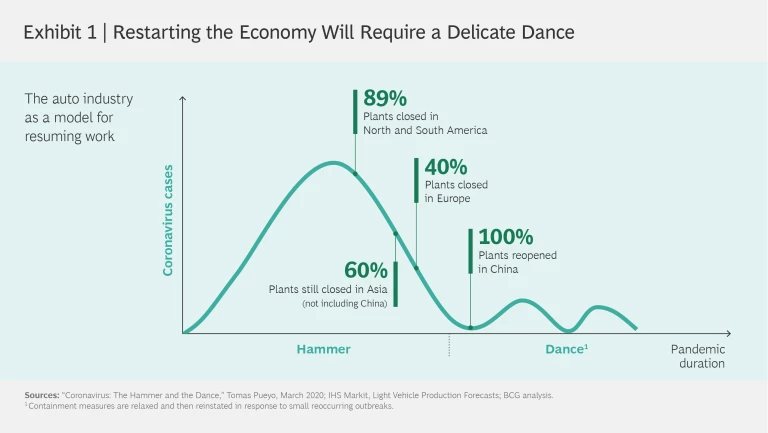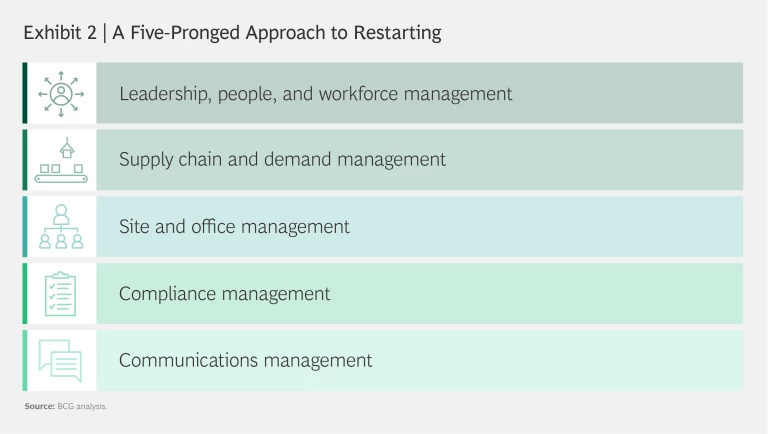As companies emerge from lockdown, they are striving to ensure the safety of their people and the continuity of their operations. And they want to do both cost-effectively and with an eye toward transformation and renewal. For most companies, returning to yesterday’s version of work is not a recipe for success, and restarting the business may not happen all at once. (See Exhibit 1.)
Although most companies will need to tailor their return to their specific culture and context, a five-pronged approach has proven to be effective. (See Exhibit 2.) We have used this approach successfully in many manufacturing industries, and it can be quickly broadened to encompass the service economy and white-collar work.
Leadership, People, and Workforce Management
Companies cannot win the fight unless their people trust their leaders and are comfortable with the risks of returning to work. Companies in Asia, and increasingly in Europe, have been building a new work model that employees have embraced. This new model has three primary components:
- Protection and hygiene considerations, including the availability of personal protective equipment, employee support and information, daily health monitoring, and smart tools
- Social distancing protocols—including split shifts and staggered start times—and enforcement
- New organizational and operational approaches that consider employee readiness to return to work, remote work, and new staffing requirements
Companies must now start to balance supply, logistics, and uncertain demand.
Supply Chain and Demand Management
In the early days of the crisis, companies understandably focused on fortifying their supply chains . This was a necessary but partial piece to the puzzle. Now they must start to balance supply, logistics, and uncertain demand. For many companies, demand is likely to return slowly and differently from before, with implications for supply chains and transportation networks. In the new reality, managing supply and demand encompasses three elements:
- Demand and production planning that is built heavily around scenarios, new potential sales channels, and asset and workforce availability
- Supplier and material availability that considers the liquidity of suppliers, the possibility of supporting them during the recovery, and continual monitoring
- Inbound and outbound logistics that ensure flexibility of storage space, transportation networks, and stock levels
Site and Office Management
Companies have one chance to get the return to work right. That is only a slight exaggeration. If they do it unsafely, they will jeopardize employees’ health, the company’s brand and goodwill, and possibly their existence. Two key initiatives need to be in place:
- Site management (including maintenance and office services) and a timeline to ensure safe access to offices and plants (including common areas, such as cafeterias)
- Asset management to ensure that the right equipment, backup plans, and monitoring systems are in place
Compliance Management
Governments have a legitimate role in monitoring and regulating the economy’s restart in order to ensure employee health and safety. In many Asian markets, for example, governments lifted and then restored restrictions in response to flare-ups of the virus. Trade unions, worker councils, and other social partners also have an interest in the restart. To ensure that operations resume smoothly, companies should do the following:
- Raise the profile of regulatory affairs in order to avoid delays, comply with new and changing rules, and take advantage of the availability of public support and subsidies.
- Collaborate with unions, councils, and other representative bodies on flexible working models, including modified shift work and remote options.
Communications Management
The best restart plans will surely fail if they are not clearly communicated to employees and all relevant stakeholders. Communications management is one of the primary tasks of leadership, and it needs to take a multipronged approach:
- Employees should have access to communications on timelines, safety protocols, and health measures, both at home and at work, and workers should be kept up to date as plans change.
- External stakeholders, including suppliers, customers, governments, and communities, should also receive relevant communications.
The novel coronavirus presents novel management challenges as work resumes. But many of the elements of a safe and controlled return to work are not entirely unfamiliar—the stakes are just higher. With so much at risk, it is crucial for companies to get the return to work right, for the health of the employees and for the sake of the business in the short and long terms.










